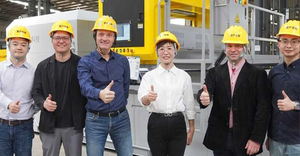E-Waste legislation key to driving economic growth.
January 1, 2010
Linda McFarland

As the United States begins to emerge from a recession, and job creation steps into the forefront of the national discussion, state and federal legislators are focusing on industries with long-term growth potential. The electronics recycling market is growing, and the right federal e-waste legislation can stimulate “green collar” job creation. Therefore, current e-waste laws need to be analyzed for best practices, and a grading system must be put into place.
In recent years, states have begun to implement e-waste legislation and, as a result, have seen an increase in the amount of electronics collected for recycling, which has directly impacted green collar job creation. Of the 21 states that have implemented e-waste legislation, five have had laws in place for at least two years, providing significant data for analysis. Two e-waste models predominate.
The first and most widely used approach, the extended producer responsibility (EPR) model used in Maine, Maryland, Minnesota and Washington, places end-of-life (EOL) recycling responsibility on manufacturers, meaning they have to collect and dispose of their electronics products. The EPR model is serviced by two companies: the Electronic Manufacturers Recycling Management Company (MRM), consisting of 17 television and consumer electronic brands, and Waste Management (WM), partnered with two television manufacturers. Both MRM and WM limit the number of recyclers allowed to participate in their programs and focus efforts within densely populated metropolitan areas.
The second legislative model, the advanced recovery fee (ARF), is used only in California and places the majority of the responsibility for electronics EOL recycling on consumers, who are required to pay a fee upon purchase. The funds raised from this fee are then allocated to a state agency that reimburses approved recyclers and collection programs.
By comparing the statistics available and the methodology of both systems, it is evident that California's ARF model is capable of creating the most jobs due to the inherent nature of it being a free enterprise system.
According to each of the states' labor departments, Maine has a total of 153 registered recyclers, Maryland has 343, Minnesota has 153 and Washington has 212, while California has 694 registered recyclers. Furthermore, the Institute for Local Self-Reliance produced information regarding job creation based on 10,000 tons recycled yearly. When applied to the collected tons from the five states, this data indicates that California's ARF system has created 3,198 jobs as opposed to the EPR model that generated only 118 jobs in Maine, 346 in Maryland, 478 in Minnesota, and 556 in Washington.
Aside from the lower rate of job creation, there is an underlying issue with the EPR model that inhibits its success. MRM and WM are primarily responsible for e-waste management in the states with the EPR model. These groups work with a limited number of vendors, making it difficult for smaller recyclers and processors to get involved.
Local economies would benefit immensely from balancing the EPR model to allow smaller organizations that collect, recycle and process e-waste for commercial and residential markets to participate in e-waste initiatives alongside MRM and WM. Currently, MRM and WM programs focus on metropolitan areas as manufacturers are required to either meet return share quotas or market share quotas. As seen in California's ARF system, smaller recyclers can control both metropolitan and rural areas with more efficiency.
A 2008 report published by the National Center for Electronics Recycling showed that Maine, Maryland, Minnesota and Washington served a combined total of 7.1 million households, collecting approximately 101.3 million pounds of e-waste whereas California alone served more than 12 million households and collected 360.1 million pounds.
Aside from the ability for smaller recyclers to collect more e-waste from more households, they are also more likely to keep green collar jobs local, thus stimulating the individual states' economies. Larger organizations, however, frequently outsource jobs to other areas, making it very difficult to directly impact local economic growth.
While the EPR model is headed in a positive direction in terms of responsible e-waste recycling, the approach lacks the muscle required to garner the statistical job creation performance of the ARF model. By limiting the business case for residential e-waste management to two primary organizations, the EPR model limits environmental benefits, competition and green collar job creation, and inhibits the potential economic gains from a promising new business sector.
Introducing a grading system that would thoroughly evaluate the candidates for e-waste recycling projects into future state and federal legislation would promote a free enterprise system within the EPR model and the electronics recycling industry as a whole. It would limit participation to companies that are financially viable, can handle the capacity, and that have e-waste processes in place. Furthermore, this grading system would ensure only companies with a proven track record for job creation in new sectors, such as e-waste and asset recovery, would be eligible.
Any grading system that is introduced should also evaluate an organization's history of environmental and wildlife preservation as well as its community involvement and partnerships with non-profit organizations and educational programs. By increasing standards, such legislation would ensure that e-waste processors and recyclers act in both an ethical and environmentally responsible manner.
It is vital for e-waste recyclers and processors to take a stand in order to ensure any future state or federal legislation put into place addresses all of these factors, from economic growth to job creation to free enterprise, and the most important factor: ethical and responsible e-waste recycling practices.
Read the "E-Waste Wishlist" sidebar to learn what the U.S. government could learn from states tht have already passed e-waste legislation.
Linda McFarland is CEO of Paragon Green, an information technology asset recovery and e-waste recycling firm, and president and CEO of Classic Computer Recovery Inc., which are both based in Garden City, Mich. She also serves as executive vice president of business development for joint venture partner 5R Processors Ltd. (5R), based in Ladysmith, Wis.
Related Stories
E-Waste Wishlist
When developing federal legislation, the U.S. government would benefit from asking some key questions of the states that have already passed e-waste legislation:
How many jobs did the legislation produce in both the government and private sectors?
How many more registered recyclers can be identified as a result of the e-waste legislation?
How many of the existing recyclers show growth from the e-waste legislation in both sales volume and jobs?
How many pounds (or tons) were kept out of landfills after the e-waste legislation was enacted? (i.e., what was the benefit to the environment?)
How much energy was conserved or saved as a result of the collections in the residential markets in these states?
How many non-profit companies were brought into the mix, and how did they benefit?
You May Also Like


